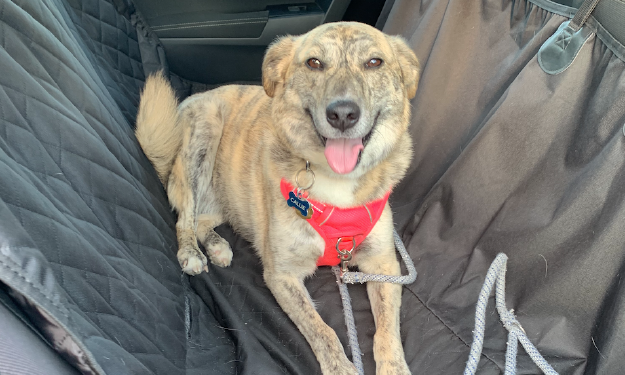Safe Car Travel With Pets: Safety Tips from a Veterinarian

Summer is a fun time of year for our furry friends. Many of us will travel this summer, and you may choose to bring along your pets. Traveling with a pet can be fun and rewarding if planned appropriately.
Quick Tips for Pet Travel Safety
Are you taking a car trip to the beaches of Maine? Or planning a camping trip with your best hiking buddy? Or perhaps a road trip across the country? Here’s a few quick tips:
- Make sure your pet is healthy enough to make the trip (especially for senior pets) and is current on his/her vaccines.
- Your dog or cat should have proper identification (ideally a microchip and a collar with tags).
- You will want to make sure the campsites and beaches you will visit welcome pets, as well as any hotels you may visit.
- When you are driving, plan to stop every 2-3 hours for stretching and bathroom breaks. And don’t feed your pet while driving!
- Start with shorter journeys, and work your way up.
- It is very important to remember that you can NEVER leave your pet in the car alone. Heatstroke can occur quickly!
Cars & Dogs Running Away
According to our partners at Granite State Dog Recovery, many dogs run away in car accidents, bolt out the door as soon as they arrive somewhere, or even fall out the car window (yes, it happens!)
Restrain, contain, and maintain your dog during car travel! RESTRAIN your dog with a dog seat belt and keep their leash on the entire trip. CONTAIN your dog in a crate if necessary. MAINTAIN your dog by making sure they have their collar & ID tags on, they’re microchipped, and have all their essentials (medications, food, a first aid kit, veterinary contacts).
The Danger of Airbags to Pets
We know it is fun to have your dog sitting on your lap, next to you in the passenger seat, or the back seat with the windows wide open. However, all these seating arrangements are very dangerous.
Airbags, when deployed, can seriously injure a dog sitting in the front seat. It can also be dangerous for dogs to stick their heads out the window since lots of flying debris can injure your dog’s face, especially the eyes.
The safest way for your dog (or cat) to travel is inside a crate that is secured. A small crate/carrier can be placed on the floor against the driver or passenger seat. A larger crate will need to be secured in the trunk space. Seat belt harnesses may also be an option but they are not all equal in quality/safety. You can check our the Center for Pet Safety website for more information.
International Travel With Pets
Bringing your pet out of the country with you? This will take much more planning, often months in advance!
Many countries have their own laws regarding pet travel and have strict rules about microchip identification and rabies vaccinations. Most countries also require the international health certificates to be endorsed by a USDA veterinarian (all of these within a specific time frame).
Check out our PAWEDcast segment on traveling abroad and International Health Certificates.
Traveling is Fun! The Key Points to Remember:
- Have your dog or cat examined by your veterinarian and make sure they are current on their vaccines, a heartworm preventative, and flea/tick preventative.
- Secure your pet in a secured crate/kennel in the car.
- If your dog gets nauseous or car sick, talk to your veterinarian about options to help alleviate symptoms.
- When planning an international trip, find out what is exactly required by the country you will visit and plan ahead of time.
- If you have any questions, consult your veterinarian.
Remember, not every pet is suited for travel. When in doubt, consider a pet sitter or boarding facility.
Written by Nako Shinohara, DVM, CVA